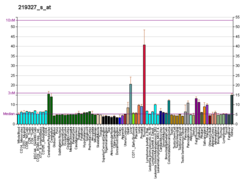The Retinoic Acid-Inducible orphan G-protein-coupled receptors (RAIG) are a group of four closely related G protein-coupled receptors whose expression is induced by retinoic acid.

Probable G-protein coupled receptor 88 is a protein that in humans is encoded by the GPR88 gene.

The prolactin-releasing peptide receptor (PrRPR) also known as G-protein coupled receptor 10 (GPR10) is a protein that in humans is encoded by the PRLHR gene.

G protein-coupled receptor 1, also known as GPR1, is a protein that in humans is encoded by the GPR1 gene.

Probable G-protein coupled receptor 19 is a protein that in humans is encoded by the GPR19 gene. GPR19 has been proposed as the receptor for the peptide hormone adropin.

Probable G-protein coupled receptor 34 is a protein that in humans is encoded by the GPR34 gene.

Endothelin B receptor-like protein 2 is a protein that in humans is encoded by the GPR37L1 gene.

Lysophosphatidic acid receptor 6, also known as LPA6, P2RY5 and GPR87, is a protein that in humans is encoded by the LPAR6 gene. LPA6 is a G protein-coupled receptor that binds the lipid signaling molecule lysophosphatidic acid (LPA).

C-C chemokine receptor type 11 is a protein that in humans is encoded by the CCRL1 gene.

Probable G-protein coupled receptor 110 is a protein that in humans is encoded by the GPR110 gene. This gene encodes a member of the adhesion-GPCR receptor family. Family members are characterized by an extended extracellular region with a variable number of N-terminal protein modules coupled to a TM7 region via a domain known as the GPCR-Autoproteolysis INducing (GAIN) domain.

G-protein coupled receptor family C group 5 member B is a protein that in humans is encoded by the GPRC5B gene.

G-protein coupled receptor family C group 5 member D is a protein that in humans is encoded by the GPRC5D gene.

Retinoic acid-induced protein 3 is a protein that in humans is encoded by the GPRC5A gene. This gene and its encoded mRNA was first identified as a phorbol ester-induced gene, and named Phorbol Ester Induced Gen 1 (PEIG-1); two years later it was rediscovered as a retinoic acid-inducible gene, and named Retinoic Acid-Inducible Gene 1 (RAIG1). Its encoded protein was later named Retinoic acid-induced protein 3.

G protein-coupled receptor family C group 6 member A (GPRC6A) is a protein that in humans is encoded by the GPRC6A gene. This protein functions as a receptor of L-α-amino acids, cations, osteocalcin, and steroids. It is a membrane androgen receptor.

60S ribosomal protein L7a is a protein that in humans is encoded by the RPL7A gene.

PRA1 family protein 3 is a protein that in humans is encoded by the ARL6IP5 gene.

Folate receptor beta is a protein that in humans is encoded by the FOLR2 gene.

Receptor expression-enhancing protein 2 is a protein that in humans is encoded by the REEP2 gene.

Solute carrier family 2, facilitated glucose transporter member 6 is a protein that in humans is encoded by the SLC2A6 gene.

Epidermal growth factor receptor kinase substrate 8-like protein 2 is an enzyme that in humans is encoded by the EPS8L2 gene.

















